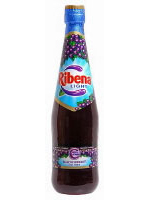 Ingredients
Ingredients-
- Water
- Blackcurrant juice from concentrate (7%)
- Malic acid
- Acidity regulators (calcium hydroxide, calcium carbonate)
- Vitamin C
- Sweeteners (aspartame, acesulfame K)
- Citric acid
- Stabiliser (xanthan gum)
- Flavouring
- Colour (anthrocyanins)
Published September 2010
This claims to be 'rich in vitamin C, a powerful antioxidant' although research in New Zealand in 2007 showed that there was none of this vitamin present in Ribena. The product was subsequently reformulated to contain vitamin C.
Ingredients
Malic acid (aka E296, chemical formula C4H6O5) is the sour taste of unripe fruits which as they ripen convert much of it to sweeter tasting molecules. It exists in both left and right hand forms of which Nature produces only the former while that produced by the chemical industry contains both. It was the presence of the right hand molecules in orange juice in the 1990s which exposed many such drinks as adulterated.
Calcium hydroxide (aka slaked lime, Ca(OH)2, E527) is added to keep the pH of the drink (which is slightly acid) at a constant level. This chemical is also used as a soil conditioner, in wall plaster, and as a straightener for curly hair.
Calcium carbonate (aka limestone, CaCO3, E170) occurs naturally as the mineral limestone and marble, and it forms as limescale when hard water is heated. It is also what egg shells, pearls, and indigestion tablets are made of. Here it also acts to stabilise the pH of the drink.
Vitamin C (aka ascorbic acid, E300) of which we need at least 60 milligrams a day of vitamin C to keep us healthy and blackcurrants contain this vitamin but the amount coming from the 7% of fruits in this drink needs to be boosted by the addition of man-made vitamin C. Traditionally Ribena was regarded as a drink high in vitamin C although when it was tested in 2007 as part of a school experiment it was found to contain none. The Ribena company was fined and now they add vitamin C to the drink.
Artificial sweeteners aspartame and acesulfame K are intense, calorie-free, sweeteners. Aspartame consist of two amino acids jointed together while acesulfame is a sulfur nitrogen molecule which is made soluble as it potassium salt (hence the chemical symbol K). Together each sweetener reinforces the sweetness of the other so very little of either is needed.
Citric acid (aka E330) is a natural acid produced by many fruits and especially oranges and lemons. It is regarded as a 'green' acid because it is produced in nature, although most is made synthetically. It is used in eco-friendly toilet bowl cleaners to remove limescale.
Xanthan gum (aka E415) is a carbohydrate that is used as a thickening agent, but it can also protect and preserve components in food which is what it does for the blackcurrant juice concentrate. Xanthan gum is made by the bacterium Xanthanomonas campestris fermenting corn starch.
Anthrocyanins (aka E163) are natural pigments which can be red, blue, or purple, and they give colour to red grapes and flowers as well as blackcurrants. The molecules consist of three rings with OH groups attached in various ways. The anthrocyanins are reputed to protect against cancer and old age because they absorb damaging UV rays.